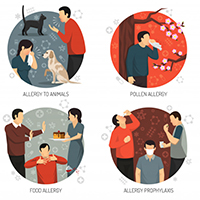Primary care management of allergic rhinitis: A cross-sectional study in four ASEAN countries
Keywords:
Allergic rhinitis, management, ASEAN, primary care, general practitioners, multidisciplinaryAbstract
Background: In primary care, general practitioners (GPs) and pharmacists are tasked with the frontline responsibility of identifying and managing allergic rhinitis (AR) patients. There are currently no consolidated data on current treatment practices, patient compliance, and usage of guidelines within Southeast Asian Nations (ASEAN).
Objective: To assess the attitudes and practices on AR of GPs and pharmacists in 4 ASEAN countries (Philippines, Indonesia, Thailand, and Malaysia).
Methods: A cross-sectional survey of 329 GPs and 548 pharmacists was conducted from May to November 2019. Participants answered a questionnaire focused on their i) current practice in the management of AR, ii) views on patient compliance, iii) understanding and usage of guidelines.
Results: Clinical history was the most preferred method to diagnose AR by 95.4% of GPs and 58.8% of pharmacists. Second-generation antihistamines were the most widely available treatment option in GP clinics and pharmacies (94.8% and 97.2%) and correspondingly the most preferred treatment for both mild (90.3%, 76.8%) to moderate-severe rhinitis (90.3%, 78.6%) by GPs and pharmacists, respectively. Loratadine was ranked as the most preferred 2nd generation antihistamines (GP vs pharmacists: 55.3% vs 58.9%). More than 90% of GPs and pharmacists ranked length and efficacy of treatment as important factors that increase patient compliance. Awareness of the ARIA guidelines was high among GPs (80%) and lower among pharmacists (48.4%). However, only 63.3% of GPs and 48.2% of pharmacists knew how to identify AR patients.
Conclusion: The survey in the 4 ASEAN countries has identified a need to strengthen the awareness and use of ARIA guidelines among primary care practitioners. Adherence to ARIA guidelines, choosing the appropriate treatment option and prioritizing factors that increase patient compliance may contribute to better management outcomes of AR at the primary care practice.
References
Bousquet J, Khaltaev N, Cruz AA, Denburg J, Fokkens WJ, Togias A, et al. Allergic Rhinitis and its Impact on Asthma (ARIA) 2008 update (in collaboration with the World Health Organization, GA(2)LEN and AllerGen). Allergy 2008;63:S8-160.
Tong MCF, Lin JSC. Epidemiology of allergic rhinitis throughout the world. In: Akdis CA, Hellings PW, Agache I, editors. EAACI Global atlas of allergic rhinitis and chronic rhinosinusitis. Zurich: European Academy of Allergy and Clinical Immunology; 2015. p. 62-3.
Katelaris CH, Lai CK, Rhee CS, Lee SH, Yun WD, Lim-Varona L, et al. Nasal allergies in the Asian-Pacific population: results from the allergies in Asia-Pacific survey. Am J Rhinol Allergy 2011;25:S3-15.
Wang DY, Chan A, Smith JD. Management of allergic rhinitis: a common part of practice in primary care clinics. Allergy 2004;59:315-9.
Brozek JL, Bousquet J, Agache I, Agarwal A, Bachert C, Bosnic-Anticevich S, et al. Allergic Rhinitis and its Impact on Asthma (ARIA) guidelines-2016 revision. J Allergy Clin Immunol 2017;140:950-8.
Bousquet J, Lund VJ, van Cauwenberge P, Bremard-Oury C, Mounedji N, Stevens MT, et al. Implementation of guidelines for seasonal allergic rhinitis: a randomized controlled trial. Allergy 2003;58:733-41.
Canonica GW, Triggiani M, Senna G. 360 degree perspective on allergic rhinitis management in Italy: a survey of GPs, pharmacists and patients. Clin Mol Allergy 2015;13:25.
Prepageran N, Wang de Y, Nair G, Maurer M. The status quo and unmet needs in the management of allergic rhinitis and chronic rhinosinusitis: a Malaysian perspective. Asia Pac Allergy 2014;4:142-8.
Baharudin A, Abdul Latiff AH, Woo K, Yap FB, Tang IP, Leong KF, et al. Using patient profiles to guide the choice of antihistamines in the primary care setting in Malaysia: Expert consensus and recommendations. Ther Clin Risk Manag 2019;15:1267-75.
Abdullah B, Kandiah R, Husna Nik Hassan N.F, Ismail AF, Mohammad ZW, Wang DY. Assessment of perception, attitude, and practice of primary care practitioners towards allergic rhinitis practice guidelines: Development and validation of a new questionnaire. World Allergy Organization J 2020;13:100482.
Navarro-Locsin CG, Romualdez JA. Attitudes, practices on allergic rhinitis of generalists and specialists in Philippine National Capital Region. Asia Pac Allergy 2015;5:203-9.
Tahamiler R, Canakcioglu S, Ogreden S, Acioglu E. The accuracy of symptom-based definition of chronic rhinosinusitis. Allergy 2007;62:1029-32.
Ferguson BJ, Narita M, Yu VL, Wagener MM, Gwaltney JM, Jr. Prospective observational study of chronic rhinosinusitis: environmental triggers and antibiotic implications. Clin Infect Di. 2012;54:62-8.
Tomassen P, Newson RB, Hoffmans R, Lotvall J, Cardell LO, Gunnbjornsdottir M, et al. Reliability of EP3OS symptom criteria and nasal endoscopy in the assessment of chronic rhinosinusitis--a GA(2) LEN study. Allergy 2011;66:556-61.
Castor MAR, Recto MT, Sumpaico MW. Correlation of skin prick test with symptoms and physical examinations finding in allergic rhinitis among Filipino Children. Phil J Allergy Asthma Immunol 2016;19:19-28.
Blaiss MS, Fromer LM, Jacob-Nara JA, Long RM, Mannion KM, Lauersen LA. Current Allergic Rhinitis Experiences Survey (CARES): Health-care practitioners' awareness, attitudes and practices. Allergy Asthma Proc 2014;35:316-22.
Marshall GD, Jr. Therapeutic options in allergic disease: antihistamines as systemic antiallergic agents. J Allergy Clin Immunol 2000;106:S303-9.
Bousquet J, Pham-Thi N, Bedbrook A, Agache I, Annesi-Maesano I, Ansotegui I, et al. Next-generation care pathways for allergic rhinitis and asthma multimorbidity: a model for multimorbid non-communicable diseases - Meeting Report (Part 1). J Thorac Dis 2019;11:3633-42.
Bousquet J, Schunemann HJ, Fonseca J, Samolinski B, Bachert C, Canonica GW, et al. MACVIA-ARIA Sentinel NetworK for allergic rhinitis (MASK-rhinitis): the new generation guideline implementation. Allergy 2015;70:1372-92.

Published
Issue
Section
License
Mattioli 1885 has chosen to apply the Creative Commons Attribution NonCommercial 4.0 International License (CC BY-NC 4.0) to all manuscripts to be published.




